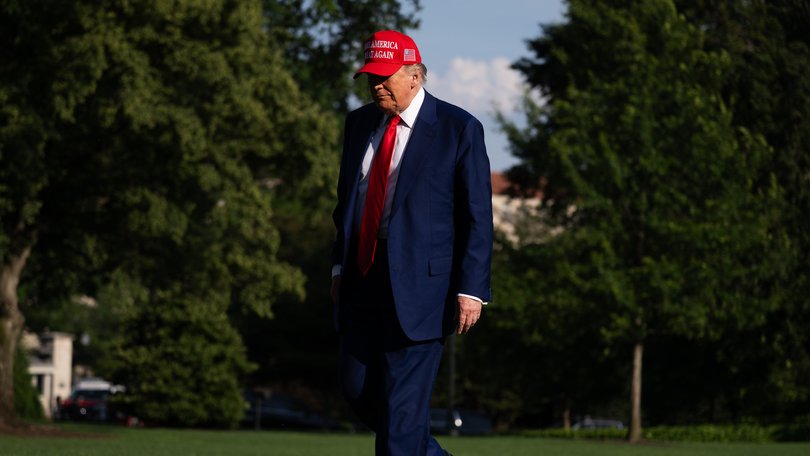Donald Trump’s strike on Iran: Here’s how the president planned and launched the attack under the radar

For days, President Donald Trump played coy about whether he would strike Iran, declaring that he hadn’t yet made up his mind even as he approved attack plans and directed military officials to ready their forces.
Within a small circle of White House and administration officials, however, it was clear that even when Mr Trump said Thursday that he might take as long as “two weeks” to decide, an attack on Iran’s nuclear facilities was imminent, and the ruse was already underway.
Just over 36 hours after that announcement, a host of military aircraft - including seven B-2 bombers - were on their way to Iran.
Sign up to The Nightly's newsletters.
Get the first look at the digital newspaper, curated daily stories and breaking headlines delivered to your inbox.
By continuing you agree to our Terms and Privacy Policy.The number of administration officials read in on the plan remained small.
Across the White House, some staff were in the dark about if and when the strikes would occur until shortly before, in some cases after, Mr Trump announced the mission to the world Saturday evening.
Air Force Gen Dan Caine, chairman of the Joint Chiefs of Staff, described the highly classified mission as one with “very few people in Washington knowing the timing or nature.”
Mr Trump’s statement about potentially waiting up to two weeks “was our attempt to throw the Iranians off guard,” a senior administration official with direct knowledge of the operation said.
“But there was also some truth to it,” said the official, speaking on the condition of anonymity because of the sensitivity of the situation.
Mr Trump had posed question after question to his advisers throughout the week about how the military could keep the operation surgical in an effort to avoid broader involvement in a war.
He made clear he reserved the right to abort the plan at any moment, up until planes reached Iranian airspace at roughly 6pm in Washington.
Mr Trump repeatedly said he was still open to a diplomatic solution. In the days after Israel’s initial strike against Iran, however, he grew increasingly positive about military action, as he watched Israel’s success and confronted Iran’s unwillingness to make the sort of drastic concessions that might have convinced him to call off the strike.
He had given Iran an ultimatum - the “ultimate ultimatum,” he termed it Wednesday - demanding that the country completely give up its ability to enrich nuclear fuel, a technology into which the nation’s leaders had poured enormous resources over two decades. The Iranians had repeatedly refused to agree to that in negotiations this spring.
Mr Trump himself never had direct contact with Iranian officials. Steve Witkoff, Mr Trump’s special envoy to the Middle East, continued diplomatic talks with Iran throughout the week.
European officials held a negotiating session with Iranian Foreign Minister Abbas Araghchi on Friday, but the White House did not expect meaningful progress to come from those talks, according to the senior official.
“He knew there probably wouldn’t be a breakthrough, which is why the Pentagon was putting together a plan” throughout the week, the senior official said.
Friday’s session “was a genuine effort by Europeans for diplomacy, but no interest from Iran at all,” said a senior diplomat involved in the meeting.
Mr Araghchi said publicly in Geneva that Iran would not negotiate about the future of its enrichment program while it was under attack - a stance that was matched by his conduct behind closed doors, the diplomat said.
After Israel began strikes on Iran on June 13 local time, some top US officials, including Vice President JD Vance, privately raised cautions about how to proceed, according to two administration officials with knowledge of the discussions.
Mr Vance, an Iraq War veteran who has long been sceptical about the United States entering wars, wanted to “make sure all the tires were kicked” as the administration discussed its military plans, and that risks to US forces were minimised.
As it became clear that Mr Trump was closing in on a plan to strike Iran, Mr Vance and the rest of his advisers supported Mr Trump’s approach, according to the senior official.
Day by day, meanwhile, Iran’s defences were being worn down by Israeli attacks, increasing the likelihood that US military advisers would assess that a bombing run of their own would be successful.
By midweek, “Israel had achieved air superiority over Iran,” said retired Lt Gen Charlie “Tuna” Moore, a former Air Force F-16 fighter pilot.
“Although we could have executed our operation unilaterally, without a doubt, it was beneficial to the United States to have that as the predicate.”
Within the administration, a sense of “camaraderie” developed among the close-knit team, according to the senior official, even as news reports swirled about internal discord.
The official insisted that accounts of Defence Secretary Pete Hegseth and Director of National Intelligence Tulsi Gabbard being sidelined were “false reporting.”
As the B-2 stealth bombers left the US in the early hours of Saturday morning, Mr Trump and his vice president were each far from the Situation Room, the president at his golf club in New Jersey, and Mr Vance in the air returning from California.
Continuing with their scheduled trips to appear at fundraisers on opposite coasts further contributed to the reduced sense of urgency among observers.
After returning from New Jersey in the early evening, Mr Trump walked into the White House just as the B-2s and support planes entered Iranian airspace.
The president made his way from the residence toward the West Wing, and within 40 minutes, the bombers were over their targets.
At 7:50 pm - 20 minutes after the bombers had exited Iranian airspace - Mr Trump and aides posted an announcement on his Truth Social site alerting the world that the attack had occurred.
Among those in the Situation Room with Mr Trump and Mr Vance on Saturday - the team that had been apprised of the secret operation in the days beforehand - were Mr Hegseth, Mr Gabbard, Mr Witkoff, Secretary of State Marco Rubio, Mr Caine, White House Chief of Staff Susie Wiles, White House counsel Dave Warrington, CIA Director John Ratcliffe and James Blair, Mr Trump’s deputy chief of staff for legislative affairs.
White House press secretary Karoline Leavitt and Dan Scavino, Mr Trump’s longtime aide who handles many of his social media posts, were also in the room and read in early on the strategy.
Attorney General Pam Bondi had not been part of the core team involved in strategising, but was added to the group Saturday.
Defence and State Department officials worked to ensure US assets and Americans in the region were protected as much as possible, while US forces there were “minimised,” according to the senior administration official.
The decision to strike was a turnabout from a generation of US leaders, Mr Trump included, who made different calculations about the risks of hitting Iran’s nuclear program.
As recently as nine days before the strikes, when the Israelis first bombed Iran, Mr Trump’s top foreign policy officials took pains to make clear that Israel was acting alone.
“Tonight, Israel took unilateral action against Iran. We are not involved in strikes against Iran,” Mr Rubio said then.
Officials who spoke to Mr Rubio in the days after that initial Israeli action said they came away thinking Mr Trump was still focused on extracting diplomatic concessions from Tehran.
That seemed to change last Monday, the day Mr Trump was at the Group of Seven summit in Canada.
He cut that trip short, saying he needed to deal with the Middle East crisis.
That night, Mr Trump warned Iran’s supreme leader, Ali Khamenei, that he could easily be killed, and told Tehran, a city of 10 million people, to “immediately evacuate.”
By Tuesday, Mr Trump had warmed to the Israeli action so much that he had begun referring to the US and Israel as a unit, posting online that “We now have complete and total control of the skies over Iran” and crediting the “American-made” equipment being used.
He reviewed the attack plans that same day, according to two White House officials.
Throughout the week, White House officials also kept in close contact with influential leaders in Mr Trump’s base, including Stephen K. Bannon, Charlie Kirk and Jack Posobiec, to make sure they were being - and felt - heard, according to two White House officials with knowledge of the communications.
Mr Bannon and Mr Kirk each paid a visit to the White House.
Officials said the president was happy to hear from Mr Bannon and other voices critical of US involvement, even though they did not sway him.
He also continued to hear from more hawkish conservative voices such as Mark Levin, even as Mr Levin was critical of Mr Trump’s claim that he wanted more time to make a decision.
“He was listening to people across the ideological perspective” of his political base, the senior administration official said.
“Ultimately, the president felt this is a decision the base should support and get behind, because ultimately, he’s preventing a conflict that very well could have happened if the supreme leader instructed Iran to create a nuclear weapon.”
Saturday, Mr Rubio made a fresh round of calls to European allies, European officials said. Europeans were told of the strikes just after they happened, according to the officials.
Those in the Situation Room with Mr Trump in recent days - including top Cabinet officials who had been apprised of recent intelligence as Mr Trump weighed the strike - were hesitant Sunday to put a time on when, exactly, the president made the decision.
The senior administration official said there was “not really a moment” that Mr Trump made his final decision.
It was based on “a feeling” the president had as he realised diplomacy would not lead to an acceptable outcome.
Mr Vance conceded on television Sunday morning that it wasn’t entirely clear at what point Mr Trump was fully on board.
“I don’t know that any of us knew exactly when the president made the decision except for the president himself,” Mr Vance said on Meet the Press.
“He himself, over time, decided this was necessary,” Mr Vance said.
“But of course, he had the ability to call off this attack until the very last minute.”
